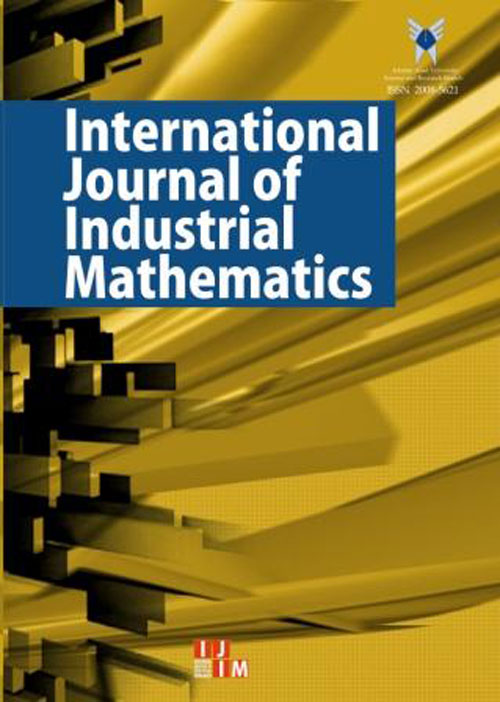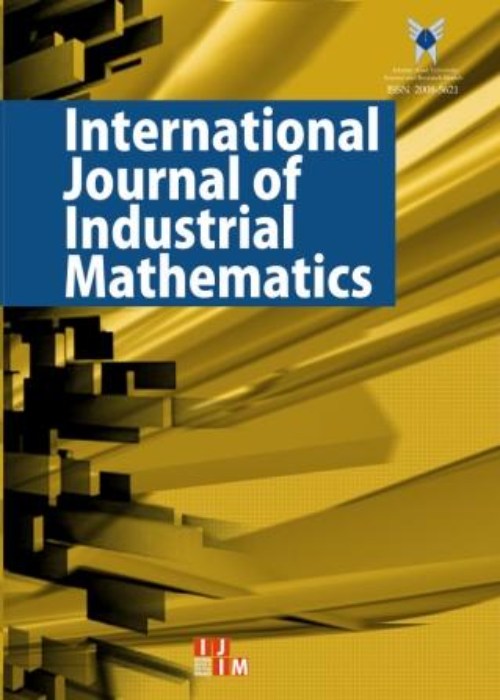فهرست مطالب

International Journal of Industrial Mathematics
Volume:7 Issue: 2, Spring 2015
- تاریخ انتشار: 1394/02/14
- تعداد عناوین: 8
-
-
Pages 121-127The performance of a supply chain can be evaluated in either a cross-sectional or a time series manner, and data envelopment analysis is a useful method for both types of evaluation. In this paper we develop an index and indicator of productivity change that can be used with radial and non-radial models for supply chain malmquist index. The supply chain malmquist productivity index (SCMPI) can be decomposed into two components: one is measuring the technical change (TC) and the other measuring technical efficiency change (TEC). So that we propose a supply chain DEA models that have supplier-manufacturer structures.Keywords: Supply chain management, Data envelopment analysis, Productivity Malmquist ýindex
-
Pages 129-138In this paper, we study the finitely many constraints of fuzzy relation inequalities problem and optimize the linear objective function on this region which is defined with fuzzy max-Lukasiewicz operator. In fact Lukasiewicz t-norm is one of the four basic t-norms. A new simplification technique is given to accelerate the resolution of the problem by removing the components having no effect on the solution process. Also, an algorithm and one numerical example are offered to abbreviate and illustrate the steps of the problem resolution process.Keywords: Linear objective function optimization, Fuzzy relation equations, Fuzzy relation inequalities, max, Lukasiewicz ýcomposition
-
Pages 139-148One main group of a transportation network is a discrete hub covering problem that seeks to minimize the total transportation cost. This paper presents a multi-product and multi-mode hub covering model, in which the transportation time depends on travelling mode between each pair of hubs. Indeed, the nature of products is considered different and hub capacity constraint is also applied. Due to the transport volume and related traffic, a new priority M/M/c queuing system is considered, in which products with high priority are selected for service ahead of those with low priority. The objectives of this model minimize the total transportation cost and total time. Besides, because of the computational complexity, a multi-objective parallel simulated annealing (MOPSA) algorithm is proposed and some computational experiments are provided to illustrate the efficiency of the presented model and proposed MOPSA algorithm. The performance of this algorithm is compared with two well-known multi-objective evolutionary algorithms, namely non-dominated sorting genetic algorithm (NSGA-II) and Pareto archive evolution strategy (PAES).Keywords: Multi, objective hub covering ýproblem, ý Priority queuing model, Multi modes, Parallel simulated ýannealingý
-
Pages 149-159The Burgers’ equation is a simplified form of the Navier-Stokes equations that very well represents their non-linear features. In this paper, numerical methods of the Adomian decomposition and the Modified Crank –Nicholson, used for solving the one-dimensional Burgers’ equation, have been compared. These numerical methods have also been compared with the analytical method. In contrast to the conventional Crank-Nicolson method, the MLCN method is an explicit and unconditionally stable method. The Adomian decomposition method includes the unknown function U (x), in which each equation is defined and solved by an infinite series of unbounded functions. Velocity parameters u in the direction of the X axis, are examined at different times with different Reynolds numbers over a fixed time step. Also the accuracy of the Adomian and the Crank-Nicolson methods at different Reynolds numbers have been studied using two examples with different initial conditions, and the Adomian decomposition method is closer to the analytical method.Keywords: Non, linear Burgers equation, Adomian method, the modified Local Crank, Nicolson ýmethod.ý
-
Pages 161-169In this paper, we present a two-stage model for ranking of decision making units (DMUs) using interval analytic hierarchy process (AHP). Since the efficiency score of unity is assigned to the efficient units, we evaluate the efficiency of each DMU by basic DEA models and calculate the weights of the criteria using proposed model. In the first stage, the proposed model evaluates decision making units, and in the second stage it establishes pair-wise comparison matrix then ranks all DMUs by AHP. Finally, a numerical example and an application of the proposed model in 23 universities are provided.Keywords: Data envelopment ýanalysis, ý Analytic hierarchy process, ýRanking
-
Pages 171-178In this paper two different methods are presented to approximate the solution of the fractional Black-Scholes equation for valuation of barrier option. Also, the two schemes need less computational work in comparison with the traditional methods. In this work, we propose a new generalization of the two-dimensional differential transform method and decomposition method that will extend the application of this methods for pricing barrier options of fractional version of the Black-Scholes model. Undoubtedly this model is the most well known model for pricing financial derivatives. This methods finds the analytical solution without any discretization or additive assumption. the approximate analytic solution is calculated in the form of convergent series with easily computable components, to solve the fractional Black-Scholes equation.Keywords: Fractional Black, Scholes equations, Barrier option pricing problem, Analytical ýsolution
-
Pages 179-185Hensel [K. Hensel, Deutsch. Math. Verein, {6} (1897), 83-88.] discovered the $p$-adic number as a number theoretical analogue of power series in complex analysis. Fix a prime number $p$. for any nonzero rational number $x$, there exists a unique integer $n_x inmathbb{Z}$ such that $x = frac{a}{b}p^{n_x}$, where $a$ and $b$ are integers not divisible by $p$. Then $|x|_p: = p^{-n_x}$ defines a non-Archimedean norm on $mathbb{Q}$. The completion of $mathbb{Q}$ with respect to metric $d(x, y)=|x - y|_p$, which is denoted by $mathbb{Q}_p$, is called {it $p$-adic number field}. In fact, $mathbb{Q}_p$ is the set of all formal series $x = sum_{kgeq n_x}^{infty}a_{k}p^{k}$, where $|a_{k}| le p-1$ are integers. The addition and multiplication between any two elements of $mathbb{Q}_p$ are defined naturally. The norm $Big|sum_{kgeq n_x}^{infty}a_{k}p^{k}Big|_p = p^{-n_x}$ is a non-Archimedean norm on $mathbb{Q}_p$ and it makes $mathbb{Q}_p$ a locally compact field. In this paper, we consider non-Archimedean $C^*$-algebras and, using the fixed point method, we provide an approximation of the positive-additive functional equations in non-Archimedean $C^*$- algebras.Keywords: Functional equation, Fixed point, ý ýPositive, additive functional equation, Linear mapping, Non, Archimedean $C^*$, ýalgebra
-
Pages 187-192The purpose of this paper is to offer the equitable method for ranking Decision Making Units(DMUs) based on the Dynamic Data Envelopment Analysis (DDEA) concept, where quasi-fixed inputs or intermediate products are the source of inter-temporal dependence between consecutive periods. In fact, this paper originally makes the use of an approach extending the ranking of DMUs in DEA by Khodabakhshi and Aryavash into the Dynamic DEA framework. Hence, firstly, we compute minimum and maximum efficiency values of each DMUs in dynamic state, under the assumption that the sum of efficiency values of all DMUs in dynamic state is equal to unity. Thus, with the combination of its minimum and maximum efficiency values, the rank of each DMUs is determined.Keywords: Data Envelopment Analysis (DEA), Decision Making Units(DMU), Efficiency, Ranking, Dynamic DEA (DDEA)ý.ý


